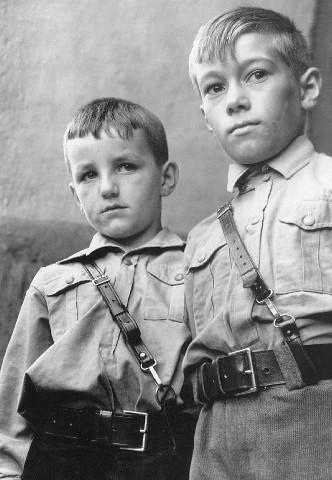
Photographers: Margaret Bourke-White (1904-71)

Figure 1.-- Margaret Bourke-While was the first important female photo journalist. Her career was nothing short of extrodinary. She began with deamatic industrial images, but gradually took on a humanitarian tone. She caopture some of the humanitarian toll of the Depression and Dust Bowl in America. She also worked in the Soviet Union and NAZI Germany, but failed to produce a single image that even hinted at the barbarity of those regimes. Here we see her photograph of HJitler Youth boys in 1938. One wonders if the thought crossed her mind when she entered the NAZI Buchenwald Concentration Camp as to how she could have missed this barabity in the 1930s. There could have been several factors, Soviet/NAZI handlers, lack of knowledge, political attitudes, or a realization that she would hve lost access if she produced suggestive images.
|
|
Most noted photographers for the first century after photography was invented were men. This did not change to any extent until the 1930s. And one of the most important of the ground breaking female phtographers is the remarkable Margaret Bourke-White. Margaret White was born in New York City (1904). Her contributiion was in photo-journalism. This was an area basically closed to women because of the greater difficulty they had in travel. Much of her career is associated with Life Magazine which before television helped bring visual images into the home. She would be the first woman documentary photographer to be accredited by and work with the American military. Margaret was the daughter of an engineer-designer in the printing industry. She attended Columbia University (1922–23), the University of Michigan (1923–25), Western Reserve University (now Case Western Reserve University), and Cornell University (1927). She took up photography as a hobby and then after Cornell pursued it as a prossesional path as a free lancer. The publisher Henry Luce was impresed by her work hired her for his new Fortune magazine (1929). That was not the best year to begin a magazine in business, but the magazine survived. Luce sent her to photograph the Krupp Iron Works in Germany (1930). On her own she entered the Soviet Uniomn to photograph the First Five-Year Plan. This was a coup, but it has ti be noted that her handlers made sure she did not photograph the britl suppression of the peasantry and the genocidal NKVD operations in the Ukraine. She was hired by Luce for Life Magazine. Her firsrt series was on Montana’s Fort Peck Dam featured on the cover of Life's first issue. Bourke-White's assignments uring the 1939s included NAZI Germany and the Communist Soviet Union, but she caoptured none of the barbarity of those regines in the dramatic way she captured the suffering of the American MidWest Dust Bowl.
Her dramatic style first focused on industrial and architectural subjects. Her assignmnts led her to increasingly focus on people and social issues as subject matter. She began to express a more compassionate humanitarian tone to her work. Here Southern novelist Erskine Caldwell was a factor. They married (1939). The marriage did mot last long, but they collaborated on three illustrated books.
She covered World War II for Life and worked with the U.S. armed forces. Actually she began the War before the United States. She was the only foreign photographer in Moscow when Hitle launched the invasion of the Soviet Union. She was taken in by the U.S. Embassy but while in Mosow photographed the defense if the city and Luftwaffe air attacks. She began her work with the U.S. armed forces in North Africa. She was torpedoed bu a U-boat in the Mediteranean, but survived and photographed not only North African canpaig, but also the Italian campaign, coming under fire in Italy. She becme know as 'Maggie the Indestructible'. She moved on to Britain in anticipation of the D-Day landings. She did not get on with General Eisenhower but was friendly with his chauffeur/secretary, Irishwoman Kay Summersby. They had shared a lifeboat in the Mediterranean. Bourke-White's phographs of Summersby raised eyebrows back home. She entered the Reich with Gen. Patton's Third Army. And captured thecterrible scenes at Buchenwald. She later remrked, Using a camera was almost a relief. It interposed a slight barrier between myself and the horror in front of me." One wnders if she ever asked herself why she never caotured the evils of NAZI Germanhy and Sioviet Russia in her 1930s work. She captured what was left of a defeated Germany with cities reduced to rubbel and the country awash with refugees trying to get home. After World War II, her major assignmnt was in Induia. She photograph Mohandas Gandhi and his austere ashram. Her final assifnment was the Korean War, this time traveled with South Korean troops.
HBC

Navigate the Boys' Historical Clothing Web Site:
[Return to:Main photographer page]
[Introduction]
[Activities]
[Biographies]
[Chronology]
[Clothing styles]
[Countries]
[Bibliographies]
[Contributions]
[FAQs]
[Glossaries]
[Images]
[Links]
[Registration]
[Tools]
[Boys' Clothing Home]
Created: 3:52 AM 9/17/2018
Last updated: 3:52 AM 9/17/2018



